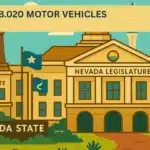on this page
Driving in Nevada presents distinct challenges from desert highways to crowded tourist areas. This guide covers essential information for safe driving under Nevada law (NRS 484A-E).
Nevada’s roads range from congested intersections like Spring Mountain and Valley View to scenic highways like State Route 166. Las Vegas traffic requires patience and defensive driving, while rural roads demand preparation for long stretches without services. Understanding these contrasts helps drivers prepare appropriately.
Key safety considerations
Nevada driving requires specific awareness of local conditions. The state’s extreme climate, variable terrain, and unique traffic patterns create situations drivers may not encounter elsewhere.
- Las Vegas Strip traffic differs significantly from I-15 or rural roads – adjust driving accordingly
- Summer temperatures regularly exceed 110°F, causing vehicle stress and tire blowouts
- Flash floods can occur suddenly in desert areas, making roadways dangerous
- Nevada has strict DUI enforcement with severe penalties (NRS 484C.110)
- Cell coverage is limited in rural areas – plan accordingly
Nevada law enforcement actively patrols highways and maintains sobriety checkpoints, especially during major events and holidays. First-time DUI offenders face up to six months in jail, fines up to $1,000, and license suspension.
Equipment essentials for Nevada driving
Proper vehicle preparation is crucial for Nevada driving, particularly for trips outside urban areas. Even short journeys can become dangerous without essential supplies.
| Critical items | Purpose |
|---|---|
| Extra water | Heat protection |
| Sun protection | Prevent vehicle overheating |
| GPS/paper maps | Navigation in no-coverage areas |
| Spare tire (not just “fix-a-flat”) | Remote area breakdown |
| Phone charger | Emergency communication |
When traveling in summer, water is your most critical resource. Dehydration can occur rapidly in 100°F+ temperatures. Window shades protect your vehicle interior and keep dashboard electronics functioning properly.
For rural driving, paper maps remain essential backup when digital navigation fails due to lack of signal. Many Nevada highways have stretches of 50+ miles without services or cell coverage.
Navigating specific Nevada driving situations
Las Vegas traffic management
Las Vegas presents unique driving challenges due to constant tourist traffic and complex casino access points. Strategic navigation can save significant time and frustration.
- The Strip (Las Vegas Blvd) moves slowly, especially weekends and evenings
- Parallel routes like Koval Lane or Paradise Road often move faster
- Hotel parking garages typically charge $15-25 daily
- Rideshare pickup zones at casinos are often in back or at specific entrances
Avoid driving on Las Vegas Boulevard during peak hours (4-7pm weekdays, 5-10pm weekends). Most casinos have multiple entrances – research your destination to identify the least congested access point. For Strip hotels, self-parking entrances are typically easier to access than valet areas during busy periods.
Defensive driving is a proactive approach to road safety, especially in Las Vegas and Reno. This practice involves awareness of surroundings and making safe decisions to prevent accidents. Traffic school teaches defensive driving techniques to help prevent auto and pedestrian accidents.
Rural driving precautions
Rural Nevada requires different preparation than urban driving. Many roads traverse remote areas with limited services and extreme conditions.
- Gas stations may be 100+ miles apart on remote highways
- Wildlife (especially deer) frequently cross roads at dusk
- Flash floods can make desert roads impassable within minutes
- Carry extra water even for short trips in summer
The “gas rule” for rural Nevada: refill whenever you reach half a tank. This provides sufficient reserve if you encounter closed or non-functional stations. Cell phone coverage maps often overstate coverage in rural areas – don’t rely exclusively on phone navigation or emergency calls.
During summer monsoon season (July-September), avoid crossing water-covered roadways. Even shallow water can conceal washed-out road sections and create dangerous conditions.
Accident protocol in Nevada
Nevada law establishes specific requirements following accidents. Understanding these obligations helps protect your legal rights and ensures proper reporting.
If involved in an accident:
- Stop immediately and check for injuries (NRS 484E.020)
- Exchange information with all drivers involved
- Report accidents with injuries or $750+ damage (NRS 484E.070)
- Document the scene with photos if safe to do so
Nevada law requires reporting accidents within 10 days if they involve injury, death, or property damage exceeding $750. Drivers must provide their name, address, registration number, and show their license to other involved parties.
Final thoughts
Driving through Nevada offers views from Valley of Fire to Lake Tahoe. Follow safe driving practices to avoid becoming a crash statistic. Traffic laws protect you, other drivers, and cyclists from accidents on the road.
Wearing safety belts is required by law (NRS 484D.495) whether driving in Las Vegas or desert roads. Seat belts reduce injury risk in accidents, making them as essential as starting your car.
Nevada roads require attention to safety. Check DMV Nevada regulations, maintain vehicle safety equipment, follow speed limits, and practice defensive driving. These steps help prevent car accidents and ensure a safe trip through Nevada. Whether navigating busy Las Vegas streets or crossing remote desert highways, proper preparation and awareness help ensure a trouble-free journey throughout the Silver State.


















